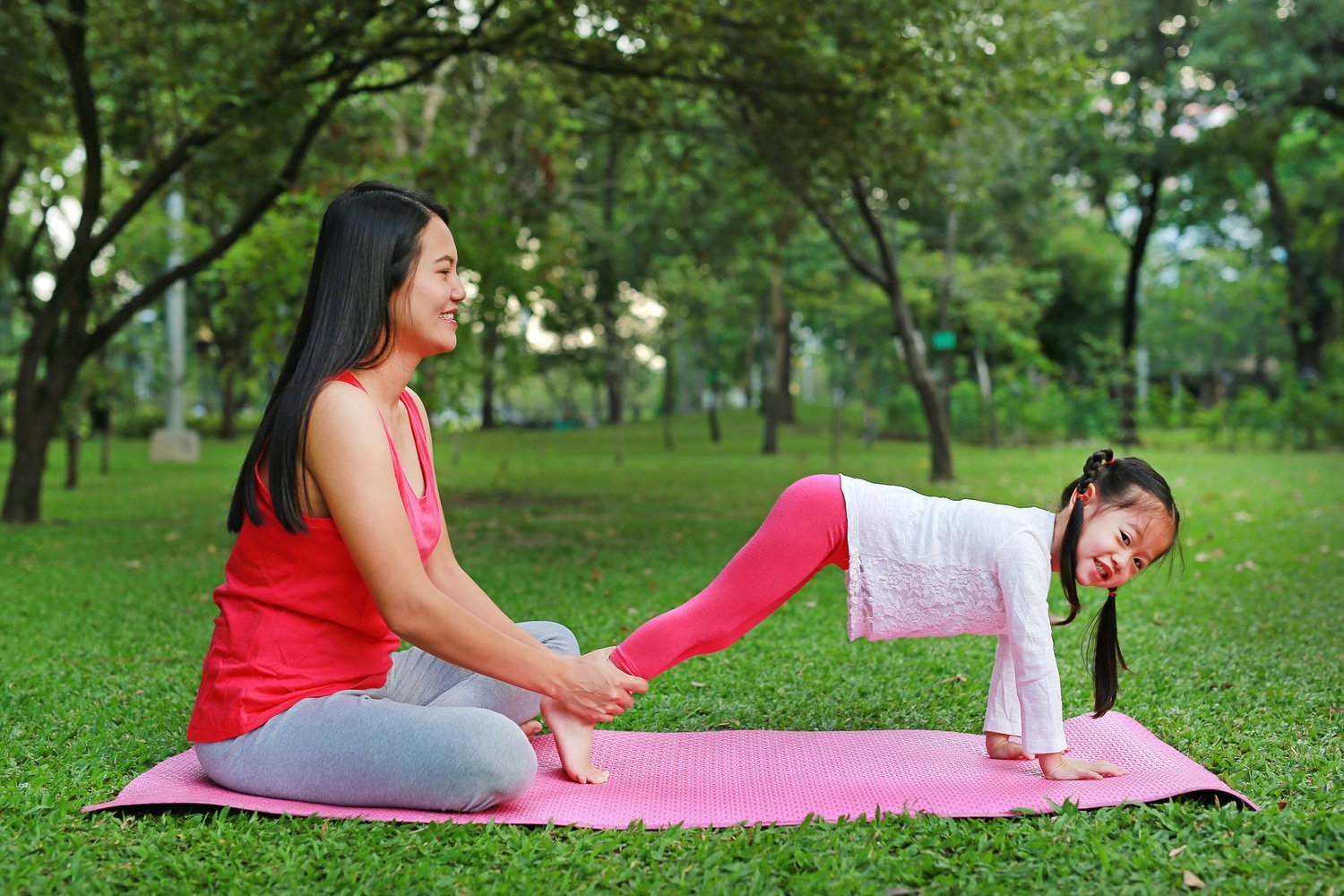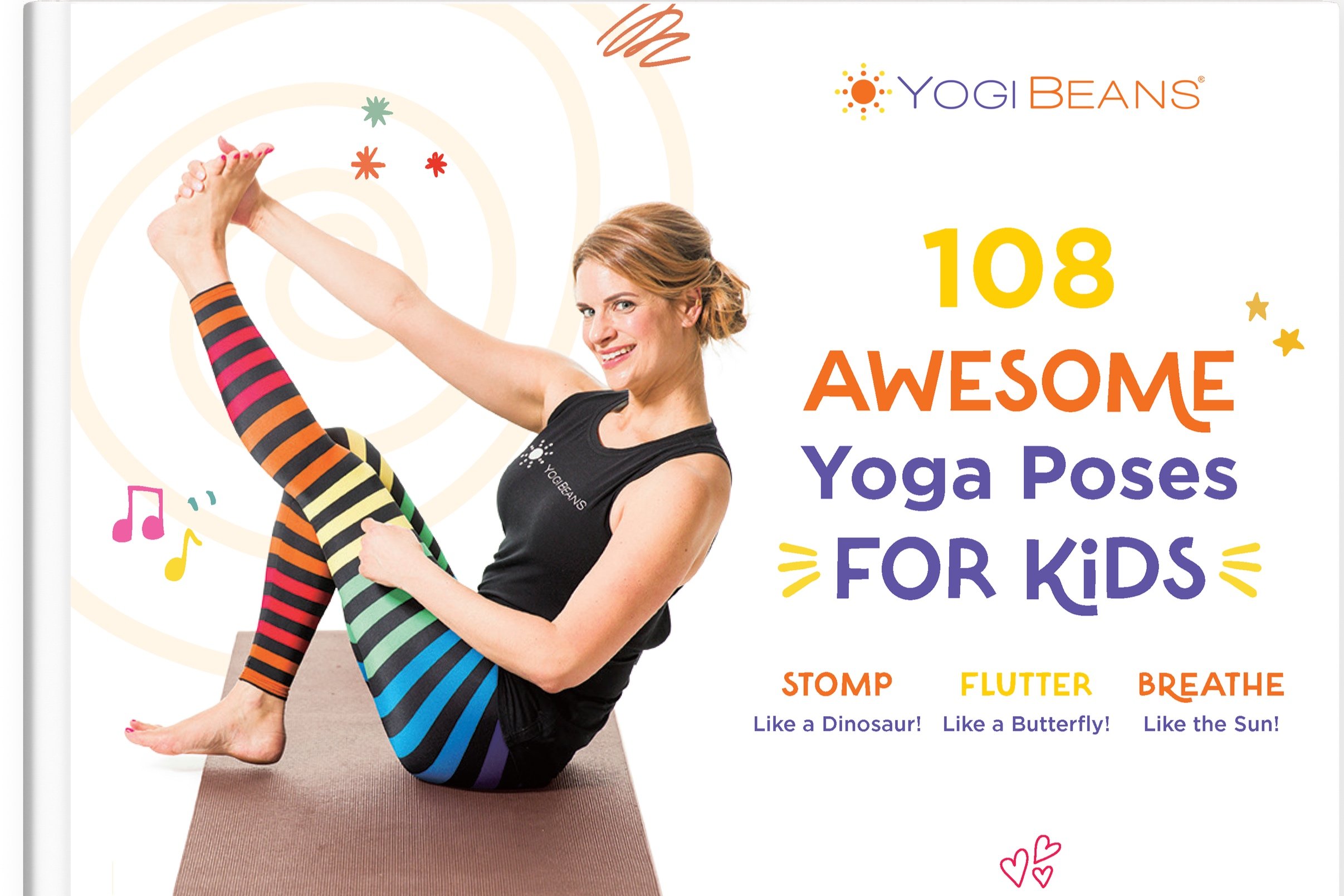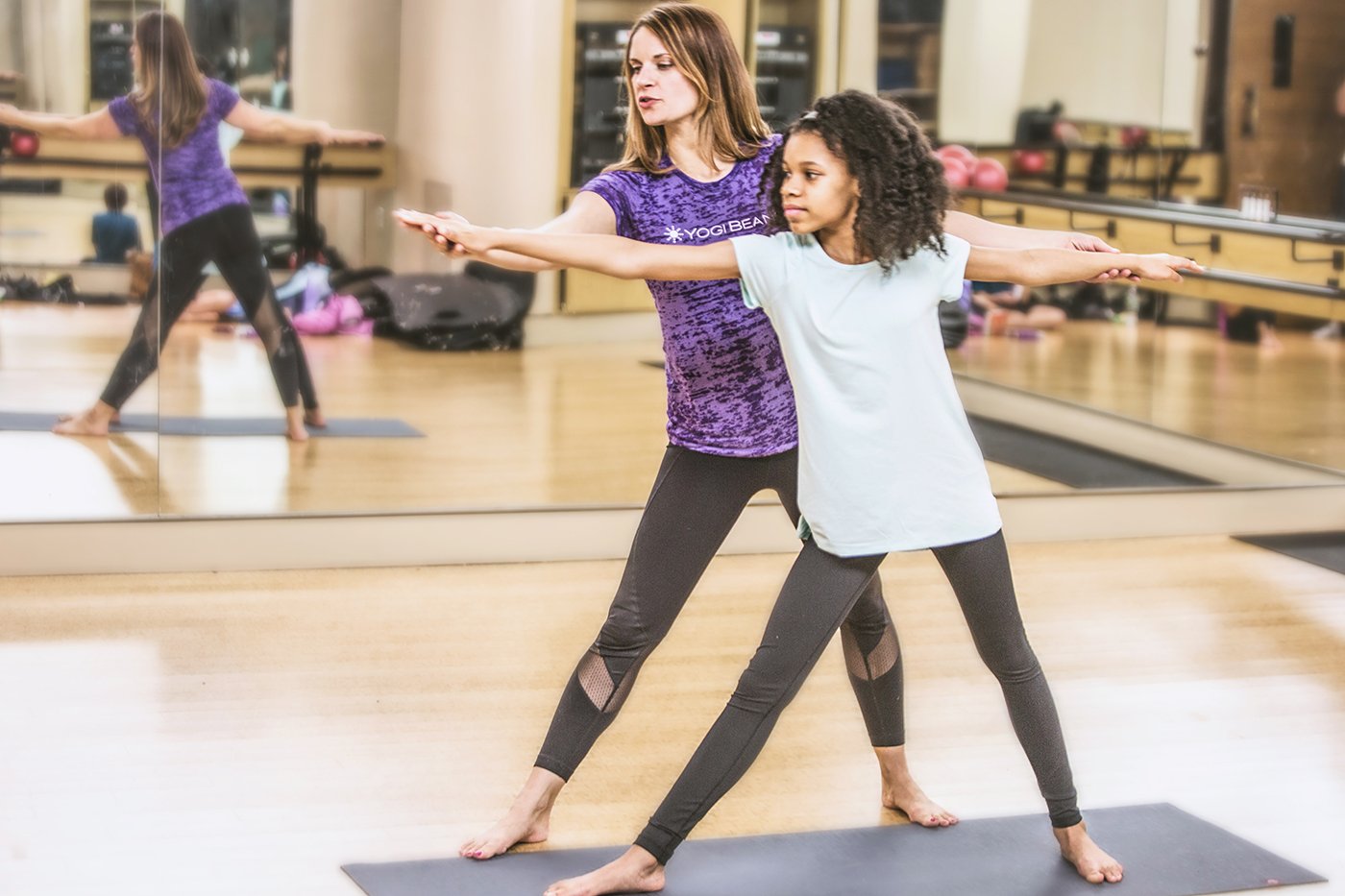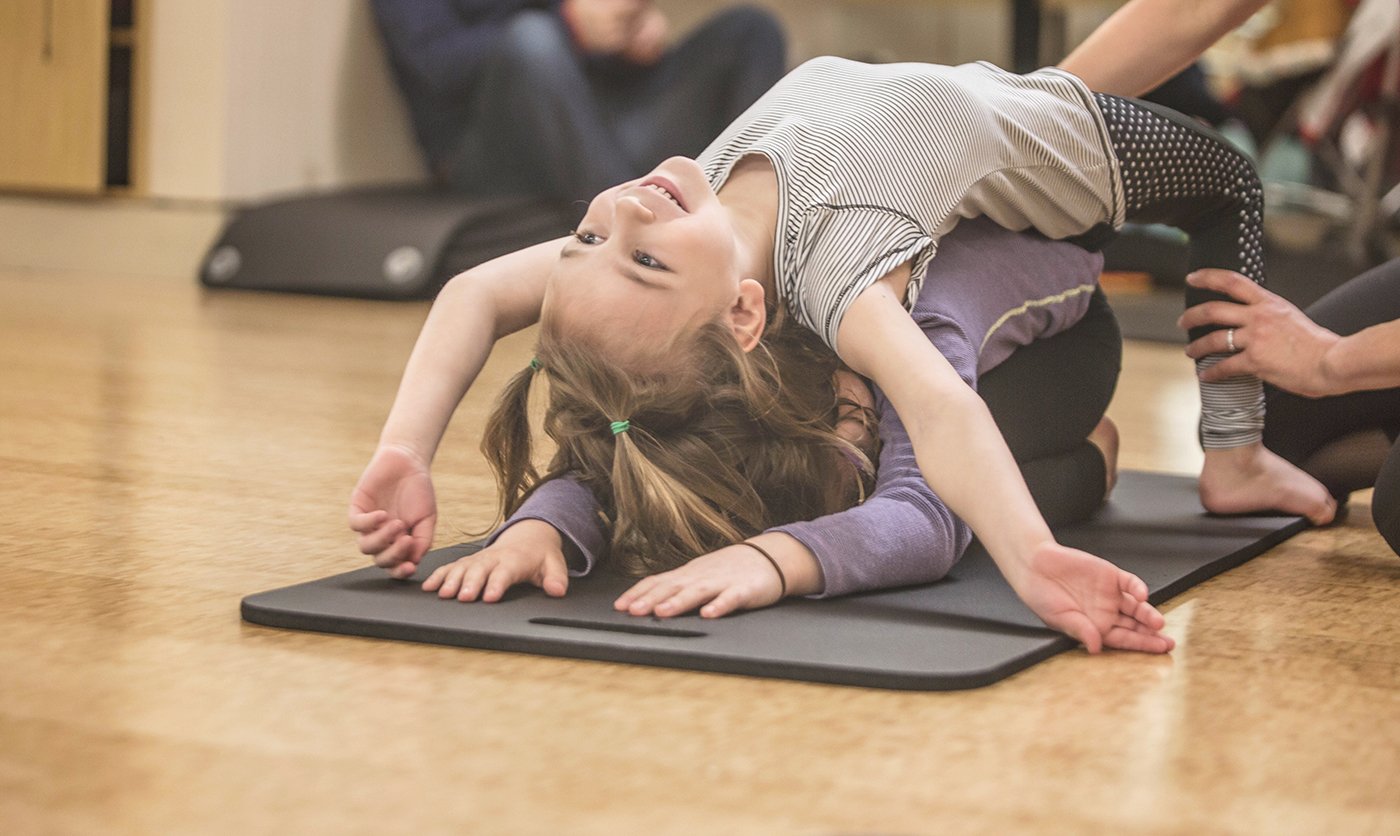12 Fun Kids Yoga Poses to Keep Your Children Balanced and Relaxed
Check out these 12 Fun Kids Yoga Poses
Yoga for kids can be a fun and playful way to introduce them to the benefits of yoga, including improved flexibility, strength, and relaxation.
Many parents are often looking for ways to engage with their children, away from the screen and technology, in ways that allow for a wholesome parent-child connection. Yoga is a great way to build a deeper connection with your children!
However, in the eyes of a child, yoga can seem a bit boring if we don't add an element of creativity and playfulness to the practice.
Want to have the best time with your children doing yoga? - Read on! It will be fun!
Make Yoga Fun with a Kids Yoga Story
If you’re looking to practice yoga with your child, the most important thing to remember is to make yoga fun!
Children respond to energy that is playful and joyous, and you want to infuse that energy into your child’s yoga practice. You can do this in a few different ways:
Play with Contrast: If you want your child to practice being still and quiet, allow them to jump, wiggle and make noise! Specifically, try contrasting the energetic movements with grounded and centering poses. For example, you can try bouncing and wiggling, and then ask your child to hold a Mountain pose (where they stand still) for up to 3 breaths. This gentle give-and-take is a surefire way to help engage your child in the practice of yoga.
Be Silly: Try not to take any yoga practice too seriously! Remind your child that it is perfectly ok to fall down, and of our Yogi Beans mantra: “yoga is a practice, not a perfect.” Try incorporating some silly faces while holding the poses or incorporate a game of freeze yoga.
Pretend to be animals: So many yoga poses are named after animals and things in nature. When practicing animal poses, have fun making animal sounds, offering up interesting animal facts and creating fun stories (e.g: the cat and cow are best friends, the downward dog is ready to chase the cat…”).
Use favorite characters: Pretend to be some of their favorite super hero or princesses and turn the yoga mat into a magical adventure space, with imaginative storytelling. Transform the traditional practice of yoga into a dynamic and entertaining experience that captures their youthful enthusiasm and curiosity.
Don’t forget the music: Choosing the right music for kids' yoga can greatly enhance the overall experience and make the practice more enjoyable. You can pick some of their favourite Disney tracks, or use the Yogi Beans playlist on Spotify and Apple Music
By now, you might have realized that engaging in kids' yoga involves a considerable amount of storytelling and creativity, which can be challenging at times.
In order to help you have the most fun with your kids, we've created a book with over 100 yoga postures and storytelling around them:
The 12 Best Kids Yoga Poses
Poses to help with focus
The use of balancing poses, along with a drishti or focused gaze, enhances concentration and focus. It helps us to find mental and emotional steadiness.
When in a balancing pose, we practice one side and then the other. It’s normal to have one side that is “stronger” than the other, and this opens up a conversation about balance in life, challenges we face, and how we can work through challenges.
1. Eagle (Garudasana)
How to: Begin in Chair pose. Bring your left leg up and cross your left thigh over your right thigh. Hook your left foot around your right calf. Bring your arms out in front and cross your right arm over your left bringing your palms together. Untwist your arms and open up your eagle “wings.” Try the pose on your other side.
Benefits: Eagle pose improves balance, focus, and body awareness. It provides a stretch to the shoulders
Contraindication: Ankle, knee or shoulder injuries
Bean tip: To enhance this pose, try folding forward so that your bound elbows tap your knees. Kids will enjoy the challenge!
2. Tree (Vrksasana)
How to: Begin in Mountain pose. Shift weight over to your right foot while lifting your left foot off the floor. Bend your left knee, bringing the sole of the left foot high onto your inner right thigh. Focus on something that doesn’t move to help you keep your balance. If you are swaying, imagine you are a tree swaying in the wind; if you fall, become a log!
Benefits: Improves balance, opens the hips, aids in focus and concentration
Contraindication: Ankle, knee or hip injury
Bean tip: Play with different variations of your hands such as a lotus mudra overhead, or create “owl eyes” with your hands! If your child struggles with maintaining balance, have them keep their toe on the ground! This will help explore the pose while also keeping them safe and grounded.
3. Airplane
How to: Begin in Mountain pose and stretch one leg straight behind you as you reach your arms out to the sides, like airplane "wings." Lift your back leg slightly off the floor as you begin to lower your torso towards the floor for “takeoff.” Fly your airplane as your leg and torso reach the same level away from the floor. Then get ready for a nose-dive landing as you lift your leg higher away from the floor and bring your torso and head closer down towards the floor. Then reverse the movements for “landing.” Repeat this series of movements on the other side.
Benefits: Creates stability in the body, helps balance, strengthens the abdominal and back muscles
Contraindication: Injury to the back, shoulders, knee, and ankle
Bean tip: Practice flying through the air in different ways! Bird, airplane, or hang glide! Have fun exploring the pose by walking normally, and then calling out the pose to pause fly through the air.
Poses to increase core strength
Core strength in children is one of the most important aspects of their physical body. Having a strong core is the foundation for posture, the ability for children to sit up correctly, both fine and gross motor skills. Even handwriting is affected by core strength!
4. Car (Dandasana)
How to: Sit up tall with your legs straight out in front of you. Reach your arms up to the sky and pull-down your "steering wheel." Remember to put on your seat belt and start your engine. Scoot yourself forward using one leg at a time.
Benefits: Helps expand the upper body while lengthening and stretching the back muscles.
Contraindication: Knee or ankle injuries and children with very weak core.
Bean tip: Be sure to follow the traffic lights and pay attention to other drivers on the road! Practice engaging the core even more by lifting one leg and then the other. Hold it for 10 seconds!
5. Ramp or Slide (Purvottanasana)
How to: Begin in Car pose with your hands a few inches behind your hips, fingers facing forward. Point your toes and lift your hips toward the sky creating a straight line between your head and your toes. Try to find the floor with your toes and open your chest to the sky as you let your head fall back.
Benefits: Opens the airway to improve breathing, strengthens the back and core muscles
Contraindication: Injury to the wrist, fingers, arms, or legs
Bean tip: Practice being a bridge or ramp for cars! Lower your hips to the ground and then lift them back up! Count how many times you can do so.
6. Boat (Navasana)
How to: Balance on your bottom and slowly lift your arms and legs into the air making a “V” position. Now make a sailboat by extending one arm straight up into the air and the other arm straight in front of you. Try switching your "sails" and hold the pose for three breaths.
Benefits: Improves core engagement and strengthens the back and hip flexors
Contraindication: Recent abdominal discomfort (stomach bug), asthma
Bean tip: Try turning your pose into a “Shipwreck” by starting in Boat pose and bringing your knees to one side as if you were in a reclining twist. Children can bend their legs for an easier alternative.
Poses to open the heart and spread kindness
Heart opening poses both help children physically and emotionally. Heart opening poses engage the muscles of the back and the shoulders to improve circulation, increase energy levels, reduce stress and can help improve posture. This theme can prompt discussions around opening your heart to others or allowing ourselves to feel vulnerable.
7. Dancer (Natarajasana)
How to: From Mountain pose, shift your weight onto your right leg. Bend your left knee and grab the inside of your left foot with your left hand. Together, kick your left foot back behind you as you extend your right arm up toward the ceiling. Repeat these movements on the other side.
Benefits: Improves balance, focus, posture, and concentration. Increases energy and helps build confidence!
Contraindication: Lower back pain or neck injury
Bean tip: Pretend to be an ice skater! Dance around the room listening to music, when the music stops find your dancer pose! See how long you can balance.
8. Upward Facing Dog (Urdhva Mukha Svanasana)
How to: Begin lying on your belly with your legs straight and the tops of your feet flat on the floor (more difficult) or your toes tucked (easier). Bend your elbows and place your palms on the floor besides your side ribs. As you inhale, begin to straighten your arms and lift your torso and legs a few inches off the floor, keeping toes tucked or feet flat. Take a few breaths and look up to the ceiling. Remind children to keep their heart lights open by rolling their upper arms back and drawing their shoulders away from their ears.
Benefits: Improves posture, strengthens spine, legs, wrist, and stretches the chest, biceps, and core.
Contraindication: Low back injury
Bean tip: Younger children will have a more difficult time with this position and it is fine to stick with a Cobra pose.
9. Camel (Ustrasana)
How to: Come onto your knees. Tuck your toes underneath so you are on the balls of your feet. Reach your hands back one at a time to grasp your heels. Bring your hips forward so that they are over your knees and arch your back. If comfortable, let your head drop back slowly, opening your throat.
Benefits: Stretches the shoulders, back, thighs and core, opens the chest increasing airflow, and aids in digestion and elimination.
Contraindication: Hernia, abdominal injury, or low back pain
Bean tip: For a more advanced variation, try practicing this pose with the tops of feet flat and toes untucked.
Poses to de-stress and unwind
Children, just like adults, crave the opportunity to relax and unwind. With the demands of school, access to toys, gadgets, and electronics, children are overworked and overstimulated. They welcome savasana, the ability to decompress and settle down. The best part? These poses can be done in the comfort of your own home. Grab some pillows, play calming music, and enjoy the benefits of these restorative poses!
10. Suspension Bridge (Setu Bandha Sarvangasana)
How to: Begin in traditional Bridge pose. With the hips lifted away from the ground, grab a block or pillow and place it underneath the bottom of your sacrum/tailbone region. Let your hips settle down onto the block. Open your chest by turning your palms up. Keep knees bent and allow your hips to melt into the block.
Benefits: Strengthens back, glutes, and hamstrings
Contraindication: Neck or back injury
Bean tip: Slide a pillow under your child’s back, let them relax into the pillow and feel the benefits of this releasing pose
11. Sleeping “L” (Viparita Karani)
How to: Lie on your back near the wall and scoot in to get your bottom as close to the wall as possible. Once in, extend your legs straight up against the wall. Bend your elbows and cactus your arms out to the sides (or think of goal-posts). Take some deep breaths.
Benefits: Releases the pelvic muscles, encourages blood flow to the heart and lungs
Contraindication: Children with eye conditions (glaucoma or detached retina)
Bean tip: Use this as a bedtime routine to prepare your child for a restful nights sleep
12. Sleeping Butterfly (Supta Baddha Konasana)
How to: Sit seated in front of a bolster or pillow behind you. Bring the soles of your feet to touch and allow your knees to flop open as in Butterfly. Place your hands by your side, and slowly lower your trunk onto the prop to support the spine. For extra support, place a yoga block underneath each knee/thigh. Once you are reclined, stretch your arms out to the sides with your palms face up to keep your chest open
Benefits: Stretches the groin, adductors, hamstrings
Contraindication: Children with weak knees or ankles
Bean tip: If you see a child’s chin jutting up towards the ceiling, take a folded blanket and place it underneath his/her head and neck to allow the muscles of the neck and shoulders to relax. This pose should feel delicious!
Conclusion
While obtaining the physical, mental, and emotional benefits of yoga, these themes can also introduce more complex discourse around childrens’ lives. Whichever way you are seeking to bring this practice to the child in your life, you have the ability to help open their mind and heart to the teachings of yoga.
These poses are more can be found in Yogi Beans book 108 Awesome Poses for Kids, which provides a fun and interactive way to introduce children to yoga poses and the mind-body-heart connection. For information on our classes and trainings, visit yogibeans.com.
Anne Davidson is a senior teacher trainer and business developer at Yogi Beans. Connect with Anne at @anneedavidson on Instagram
Connect with us!
Welcome Friends!
Yogi Beans is a yoga and wellness company for children. Come make the world a brighter place with us!
Teach Kids Yoga with Confidence & Joy!
The Ultimate Guide to Plan the Best Kids Yoga Lesson
Learn how to prepare a super fun kids’ yoga class
Would you like to plan the best kids' yoga lesson filled with exciting poses, engaging games, and heaps of fun?
You’re in luck because, at Yogi Beans, we have crafted the perfect guide to assist you in creating a fantastic yoga class for children.
Designing a kids' yoga lesson requires a thoughtful approach to engage and inspire young minds. At Yogi Beans, we've been providing yoga teacher training and guiding parents and childcare professionals on the safest and most enjoyable ways to engage children in yoga.
Here's a comprehensive guide to help you plan the best kids' yoga lesson:
How do you structure a yoga class for kids?
1. Welcome them with Warmth and Excitement (10 minutes):
Greet the children with a lot of enthusiasm.
Open the class with a circle.
Use a simple icebreaker activity to help them get comfortable and engaged: Play some music and invite them to move their bodies and shake out their wiggles for a couple of minutes.
Once everyone had a bit of fun and feels more relaxed and connected, you can start the class with a tune-in activity such as ringing a bell, singing a song or saying the sound of OM
2. Introduction to Yoga (1-3 minutes):
Briefly explain what yoga is in a child-friendly manner.
Share the benefits of yoga, such as flexibility, balance, and relaxation.
3. Breathing Exercises (5 minutes):
Teach simple and playful breathing exercises (lion’s breath).
Relate breath awareness to calming the mind and body.
4. Warm-Up (5 minutes):
Start with gentle warm-up exercises to prepare their bodies for movement (animal walks, neck rolls…).
Incorporate activities like stretching, reaching, and light cardio movements.
Teach Sun Salutations
Our Yogi Beans song, Mountain Moves, which is found wherever music is streamed, is great for a simple warm up!
Listen to Yogi Beans Music on Spotify or Apple Music
5. Theme Introduction (1-3 minutes):
Introduce the theme or the “yoga adventure” for the session (animals, superheroes…).
Connect the theme to the benefits of specific yoga poses. (eg: Outerspace theme can teach us about the unknown)
6. Yoga Poses (10 minutes):
Demonstrate and guide children through a series of age-appropriate yoga
Incorporate poses related to the chosen theme.
Feeling a bit low on inspiration? No worries! We've whipped up a fantastic book packed with over 108 lively kids' yoga poses, each paired with a story idea. Give it a chance, this book might just become your ultimate sidekick in the awesome adventure of teaching yoga to kiddos!
7. Games (15 minutes):
Integrate yoga-themed games that require focus and concentration.
Include unifying activities that promote collaboration and teamwork.
Try incorporating one high-energy game and one low-energy game
Need more yoga games? Our online trainings will teach you many fun mindful games that can be incorporated into your children’s yoga classes.
8. Creative Expression (10 minutes):
Allow children to express themselves through art or movement.
Incorporate a creative element related to the yoga theme (dance, drumming, drawing, and journaling prompts for older children, etc.)
9. Relaxation/Mindfulness (5 minutes):
Guide children through a brief relaxation or mindfulness exercise.
Use props like soft music or imagery to enhance the experience.
Always end with the final resting pose Savasana
10. Closing and Gratitude (5 minutes):
Gather the children for a closing circle.
Express gratitude, recap the session briefly, and encourage sharing.
Keep this in mind—it's all about finding the groove between order and playfulness. Strike that sweet balance where structure meets flexibility, leaving plenty of space for creativity and the unexpected joys sparked by the kids' reactions and interests!
Don't Forget to Make it Fun and Interesting
Preparing a kid's yoga class that is as fun as a circus requires a dash of creativity, a sprinkle of playfulness, and a whole lot of variety. It's like planning a party where the guest of honor is laughter!
Here are some top tips to turn your class into the coolest hangout for tiny yogis:
Find Your Kid’s Yoga Theme:
Plan your class around an exciting theme like animals, nature, or favorite storybook characters. Weave the theme into yoga poses and activities for a cohesive and captivating experience.
Create an Interactive Kid Yoga Storytelling:
Tell stories that involve yoga poses. Encourage children to act out the characters or elements of the story through corresponding poses. Allow them to contribute to the story or suggest their own imaginative twists.
Use Props and Visuals:
Integrate colorful mats, props, and visual aids to enhance engagement. Props like soft toys or imagery cards can make the session more interactive and enjoyable.
Incorporate Games:
Introduce games that involve yoga poses, like "Musical Mats” (musical chairs with yoga mats and yoga poses). Games add an element of excitement and keep the children actively participating.
Creative Transitions:
Make transitions between poses fun by incorporating playful movements or short dances. Use music and encourage the children to express themselves freely during transitions.
Music and Movement:
Use lively and age-appropriate music to accompany poses and activities. Incorporate rhythmic movements or dance breaks to keep the energy high.
Partner Poses:
Introduce partner or group poses to foster teamwork and social interaction. Children can work together to create shapes or support each other in balancing poses.
Expressive Breathing Exercises:
Teach simple breathing exercises with imaginative names. Connect breath awareness to fun activities, making it an integral part of the session.
Encourage Choice and Independence:
Provide options for poses and activities, allowing children to choose what resonates with them. Offer opportunities for them to express their preferences and ideas.
Celebrate Achievements:
Acknowledge and celebrate small achievements, whether it's holding a pose or expressing creativity. Create a positive and supportive environment.
We hope that you enjoyed our ultimate guide to plan the best kid’s yoga lesson!
If you're eager to dive deeper into the world of kid's yoga or want to specialize in a particular aspect of bringing zen to tiny tots, Yogi Beans has a treasure trove of training waiting for you! Whether you're laying the foundation for teaching yoga to kids, exploring the intricacies of Kids' Yoga anatomy, or delving into the world of kid's yoga for special needs, we've got a kaleidoscope of skills to add some sparkle to your yogi journey.
Connect with us!
Welcome Friends!
Yogi Beans is a yoga and wellness company for children. Come make the world a brighter place with us!
Teach Kids Yoga with Confidence & Joy!
Here is why you should absolutely try Laughter Yoga!
Laughter is the best medicine to relieve stress
Why is the apple so good at yoga? He has a great core!
When it comes to relieving stress, soothing tension, or even to just improve your mood — laughter is the best medicine! This is phrase is said so often because laughing has so many important benefits.
In Sanskrit, the word līlā (lila) translates to “divine play.” We love to incorporate this phrase into our children’s yoga classes and in our children’s yoga trainings so that adults who work with children can begin to incorporate this sentiment. The idea of “divine play” plays a role in laughter in yoga.
Laughter allows us to release our inhibitions and embrace more joy in our experiences. As adults, we have learned that such expressions can also have negative consequences such as feeling embarrassed. It is important to invite this element of joy, silliness, and laughter with our children because it allows them to embrace out-of-the-box thinking and to expand their individual boundaries.
What is Laughter Yoga?
The practice of Laughter Yoga supports deep breathing (pranayama) combined with playful exercises that promote energy, uplift our mood, and also provide many health benefits. Laughter Yoga is a practice designed by Dr. Madan Kataria in 1995. Dr. Kataria began his study of laughter yoga based on its many important psychological and physiological benefits.
In his work, Dr. Kataria proposed that laughter can be taught and experienced in community and group exercises. Laughter Yoga is a practice where students learn to laugh on cue rather than relying on people, things, or experiences to bring them joy. The practice provides various movements, breathing exercises, and activities that teach people to create intentional laughter.
Most Laughter Yoga classes for adults begin with simple breathing and chanting to help students turn inward and begin to relax. They also may include improv exercises to help you relax and laugh. While it may feel silly to chant “he-he-ha-ha,” the exercise allows you to leave your ego at the door and practice the element of ahimsa, which yogis know is the Sanskrit word for non-judgement.
For children, Laughter Yoga is a way to bond with friends and family members in a non-competitive way that also boosts everyone’s mood!
What are the benefits of Laughter Yoga?
A good laugh has both short-term and long-term effects.
Short-term, laughing can relieve stress and tension, stimulate oxygen in the body, as well as lower blood pressure. Laughing releases our happy hormones (dopamine and serotonin) while suppressing our stress hormone (cortisol). Long-term, laughing can improve your immune system by relieving pain as the good endorphins from a laugh stimulate a response similar to painkillers, thus promoting an overall good mood. Laughing is an antidote for tension relief, it increases blood flow to the brain and also serves as a cardiovascular exercise.
Laughter Yoga is especially beneficial for children as it is a great way to support cognitive function. With increased blood flow to the brain, laughter can improve focus, memory, and support brain development.
Along with the physical benefits of Laughter Yoga, the practice also provides a deeper connection between people, family members, children and people in their community.
If you have not already, try to practice Laughter Yoga with your loved-ones; it is by far one of the most effective ways to strengthen your family bond!
5 easy Laughter Yoga exercises for you and your loved ones
Children are inherently free of inhibition. They are always looking for joy in the things around them, laughing at jokes, making other people laugh and they love funny faces.
Babies and children both laugh and smile in their sleep! Here are some ways that we like to introduce laughter and play in yoga :
Mirror Me: In our family yoga classes, we introduce a game called “Mirror Me.” In this game, caregiver and child sit facing one another. With one person as the leader, they can begin to model different movements and have the other person follow. To incorporate the concept of laughter yoga, the leader can begin to make funny faces, or make funny movements, and then gradually begin to make sounds that build up into either silly sounds (to make the other person laugh) or different sounds of laughter. The other person is then asked to model the faces of movements.
Telephone Laughter: Similar to the game of Telephone, children being by standing in a circle. Think of a secret to celebrate such as “no school tomorrow!” or “ice cream for dinner!” As children hear the celebration, ask them to high-five and cheer with one another until you get to the last person.
Laughing Breath/Breathing Staircase: This exercise begins with each child lying his or her head gently on another child's belly. Ask children to notice their partner’s breath, and how it affects their head movement. Ask them to let out a hearty laugh and explain what is happening. The more children participating, the more laughter will erupt!
Joker and the King: This is a fun and silly game that can be used when your group is feeling cranky or tired. One player is the king and they start out by saying “Betcha’ can’t make me laugh.” The other players come up to the king one at a time and, moving with yoga poses, to see if they can be so silly that they make the king laugh.
Joking Warriors: In our kids yoga classes, we teach warrior poses (ages 5+) succinct with affirmations (e.g., I AM: Proud Warrior). We often ask children to lead the group, recite an affirmation, and come into a yoga pose.
So, what’s the punchline? Laughter yoga is a great way to support your child mentally, physically and spiritually. The practice allows children to build resilience, express themselves, and connect with friends and loved ones.
For more information on Yogi Beans, to experience these exercises in our trainings, or how you can bring children’s yoga to the children in your life, visit our website!
Anne Davidson is a senior teacher trainer and business developer at Yogi Beans. Connect with Anne at @anneedavidson on Instagram
Connect with us!
Welcome Friends!
Yogi Beans is a yoga and wellness company for children. Come make the world a brighter place with us!
Teach Kids Yoga with Confidence & Joy!
Watch! Book release & talk with 92NY and Yogi Beans
Book release and talk with 92NY and Yogi Beans
Watch the 92NY Spark Your Health event for a children’s movement, wellness-inspired talk and book release of 108 Awesome Yoga Poses for Kids with founder of Yogi Beans, Lauren Chaitoff, and moderated by Katera Noviello-Kapoor.
Topics covered in the talk include:
How we can help children foster their mind-body connection
How we can encourage children to move more in a highly sedentary society
How can yoga support the growing mental health crisis facing our children?
How to incorporate yoga poses into your child’s morning & evening routines (and the benefits of doing so)
The philosophy behind bringing yoga into the classroom
Order your copy of 108 Awesome Yoga Poses for Kids.
Yogi Beans is a yoga and wellness company for children. Come make the world a brighter place with us at @yogi_beans on Instagram
Connect with us!
Welcome Friends!
Yogi Beans is a yoga and wellness company for children. Come make the world a brighter place with us!
Teach Kids Yoga with Confidence & Joy!
Kids yoga: when should kids start?
Learn when kids can start practicing yoga!
Kids yoga classes provide children with the opportunity to connect the body, mind and heart. These classes teach kids to internalize concepts of self–awareness, compassion,
In a kids’ yoga class, children are free to play, explore, question and grow their yoga practice in a non-judgmental and welcoming environment. Children are faced with numerous expectations in both school and their social lives, while also constantly stimulated by the internet, gaming, and social media. Now more than ever, the tools necessary to live a more mindful life are just as important for young people as they navigate the world.
Many have asked the question: can yoga really help children balance life and maintain a child’s mental health and wellbeing? This article will tell you everything about kids yoga benefits and when your children can start practicing.
Is Yoga Really Appropriate for Children?
Many schools around the country are beginning to incorporate yoga, SEL practices, and meditation within the school day because of yoga’s benefits for children. Some of these include increased strength and flexibility, breath and body awareness, increased focus and learning to relax.
In a 2016 Harvard Medical Study, “A growing body of research has already shown that yoga can improve focus, memory, self-esteem, academic performance, and classroom behavior, and can even reduce anxiety and stress in children.” * These studies also posit that with the benefit of increased focus and learning to relax, yoga can help children with attention deficit hyperactivity disorder (ADHD), support executive functioning, and can aid children with special needs.*
Today, children are experiencing more stress than ever to meet the standards of education, their caregivers, and social expectations. The practice of yoga is a tool that can help children deal with these stressors and provide the tools to help self-regulation.
When Should Kids Start Yoga?
Children are natural yogis and many studios begin to incorporate yoga for children as young as 6 weeks of age. The exercises in a baby yoga class enable a connection between baby and caregiver, and aid in physical and mental development.
As children grow, yoga classes for toddlers, preschoolers, elementary aged children, and tweens and teens begin to enhance the teachings of yoga by incorporating a more physical practice and layering in the mindful and meditative connection to the body.
At Yogi Beans, our kids yoga trainings are designed for real world applications in studios, classrooms, virtually and beyond for all age groups. For example, our Baby Bean Yoga Training teaches simple baby stretches, songs and poses designed for you to lead a class for infants to crawlers. Our training, The Building Blocks of Teaching Yoga to Kids, focuses on how to teach children from ages 2-10.
If you’re looking to learn on your own time, Yogi Beans offers a Video On Demand Training that provides a comprehensive look into creating and teaching a children’s yoga class including Pranayama (breathing), Asana (poses), mindful games, and meditation and Savasana.
What Type of Yoga is Good for Kids?
Creating an age-appropriate structure for a children’s yoga class is important. What works for a two-year-old will certainly not work for a ten-year-old!
The younger the child, the shorter attention span they have and the more movement activities they need.
Whereas with older children, refinement of yoga asanas as well as deeper looks into meditation, journaling, and mindfulness can begin to be applied.
Baby Yoga (6 Weeks-Crawlers): In a baby yoga class, anything can happen! These little beans are just beginning to recognize their body and explore their body’s limitations. These classes involve a caregiver to be present to assist the baby’s needs. Like all children, babies learn from example.
These classes provide an opportunity for caregivers to move their body in traditional yoga poses, while also allowing the baby to experience songs, gentle movements, and begin to form that mind-body connection.
Yoga for Toddlers (Ages 2-3): Children of this age have a lot of energy and once they are on their mats, expect to see a lot of movement! The general instruction and approach to class ought to be lively, lighthearted and flexible. The class should move at an energetic pace and the poses should be kept simple.
These classes involve songs, chants, and lots of contrast, while also exploring big explosive movements, before finding opportunities for stillness and calm.
Yoga for Preschoolers (Ages 3-4): Since younger children have short attention spans, your class format for this group still moves at a fast pace. Children of this age learn best through simple hands–on exercises, use of fun props and the repetition of songs, games and playful yoga poses.
Most importantly, class structure should remain consistent each week; obedience to directions should be encouraged but, generally speaking, not disciplined.
Yoga for Elementary Schools (Ages 5-7): Children of this age are advancing in physical and cognitive development and can readily engage in group discussions.
Make class extremely imaginative and introduce all age–appropriate poses and activities in a thoughtful sequence. Incorporate easily understood explanations of breathing techniques, yoga poses and concepts related to focus and concentration, while keeping the overall class environment light and fun. Teach the importance of following directions, and the consequences of misbehavior and disruption on the group’s experience.
Yoga for Late Elementary Schools (Ages 8-10): Instruction for this age group should begin to incorporate more challenging concepts and poses. Poses should be held for longer durations with a basic introduction to postural alignment. Focus on working both sides of the body to acknowledge the imbalances in all of us and increase strength and flexibility. Discussion of basic yogic concepts and terminology can be infused throughout class as well as pranayama (breathwork) such as Nadi Shodana breathing.
Children in these classes can also begin to explore more meditation and different exercises, where they have to tune inward, such as journaling, coloring mandalas, or the game Rose and Thorn.
If you want to learn how to practice yoga with your kids safely, have a look at our online courses. They’re easy, affordable, and you can learn how to practice yoga with your children at your own pace.
Whether you’re a caregiver, teacher, yogi, or someone who has a passion for yoga and working with children, the benefits of incorporating this will help children to become their highest and most mindful selves.
Anne Davidson is a senior teacher trainer and business developer at Yogi Beans. Connect with Anne at @anneedavidson on Instagram
Connect with us!
Welcome Friends!
Yogi Beans is a yoga and wellness company for children. Come make the world a brighter place with us!
Teach Kids Yoga with Confidence & Joy!
Yoga for kids anywhere
Join Lauren on Omstars! Get your kids to start practicing yoga
Join Lauren Chaitoff and Yogi Beans, available exclusively on Omstars! Get your kids to start practicing yoga with Lauren Chaitoff's Yogi Beans Course on Omstars! This course offers classes designed for children aged 3 to 13 to immerse themselves into the world of yoga.



















